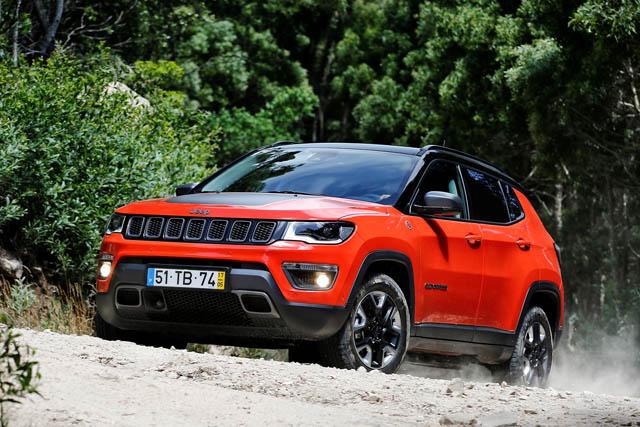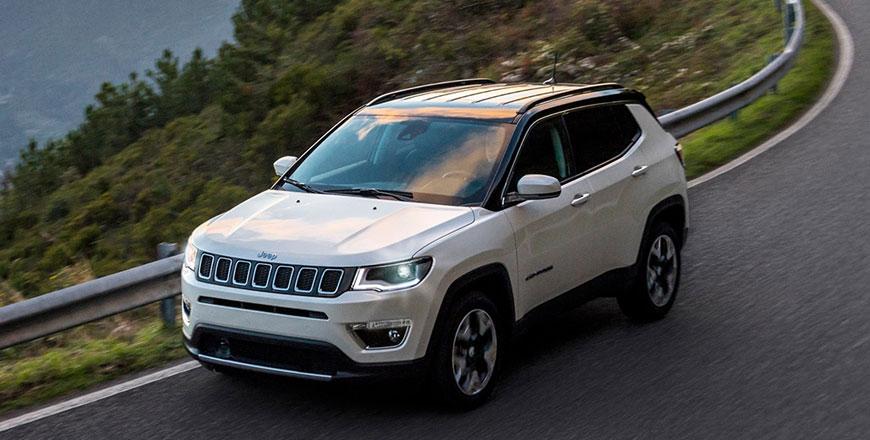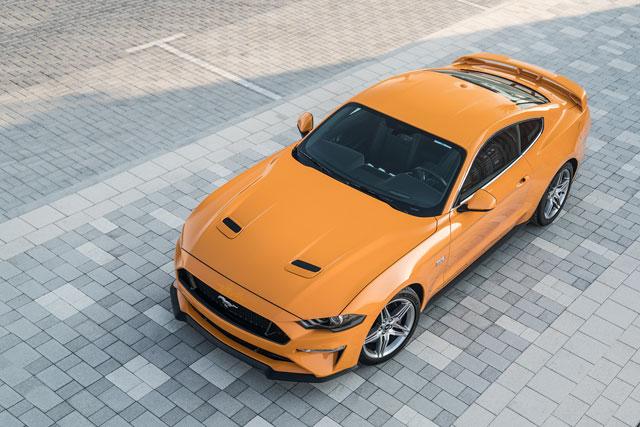You are here
Jeep Compass Trailhawk 2.0 Multijet: On the right trail
By Ghaith Madadha - Jun 19,2017 - Last updated at Jun 19,2017

Photos courtesy of Jeep
That from afar and to the untrained eye, the new Jeep Compass seems uncannily similar to the iconic off-road brand’s largest Grand Cherokee flagship is something that is not wholly unintentional. Capturing the uncompromisingly capable yet advanced and luxurious Grand Cherokee’s visual cues in somewhat miniature scale, the range-topping Compass Trailhawk version also encapsulates the off-road ability and rugged sense of freedom at the heart of the SUV phenomenon and particularly the Jeep brand.
Uniquely combining genuine and extensive ability in a thoroughly modern package pitched at the increasingly more popular yet more car-like compact SUV and crossover segments, the Compass is refined, comfortable and efficient on-road, and packed with contemporary gadgets and tech.
Rugged and authentic
Launched globally last week and expected to arrive in Middle East markets after a regional debut at the Dubai Motor Show in November, the Jeep Compass is offered in a range guises, engines and specification levels, but the pick of the crop is undoubtedly the strongly off-road biased Trailhawk, which carries the brand’s coveted “Trail Rated” badge of honour to indicate its off-road abilities.
Shod with more off-road biased and forgiving tyres instead of bling items, the Trailhawk also receives underbody skid plates, higher 216mm ground clearance, and re-styled fascia for much enhanced 30° approach, 24.4° break-over and 33.6° departure angles to easily tackle treacherous off-road conditions, ruts, rocks and peaks.
Bearing an aesthetic relation to the Grand Cherokee, rather than styled as homage to the brand’s iconic Wrangler — as the original Compass circa 2006 and contemporary entry-level Renegade — the new Compass is compact yet wide, with short overhangs for improved off-road and on-road driving. With moody squinting headlamps flanking Jeep’s signature seven-slot grille, the Compass also features flared trapezoidal wheel-arches for a more assertive road stance.
In rugged Trailhawk specification, it receives unique 43cm alloy wheels, rear tow hook and a higher more steeply angled bumper to dramatically improve its approach angle. An optional black roof and contrasting matt bonnet finish also lend it a sportier, more rugged and urgent charisma.
Versatile delivery
Available with only two four-cylinder engine options in Trailhawk guise, the Compass is due to arrive in regional markets with Jeep’s naturally-aspirated 180BHP and 175lb/ft ‘Tigershark’ 2.4-litre petrol. However, at launch in Portugal and as driven, the Trailhawk was powered by the wider Fiat Chrysler Group’s gutsy, capable and frugal 2-litre common-rail turbo-diesel “Multijet” engine developing 167BHP at 3750rpm and 280lb/ft at 1750rpm.
Quick-spooling, responsive and with a broad sweet spot by turbo-diesel standards, the Trailhawk “Multijet” also benefits from a slick 9-speed automatic gearbox, with a wide range of ratios to minimise turbo-lag from standstill, improve responses, flexibility and high speed refinement and consistency and fluency in delivery.
The right engine for the right vehicle with plenty of grunt for versatile overtaking on the highway and for climbing inclines and off-road trails easily, one hopes that Jordanian restrictions on modern turbo-diesel passenger vehicles will be eased in the future. Capable of carrying the 1615kg Trailhawk through the 0-100km/h sprint in 9.5-seconds and onto 196km/h, the 2.0 Multijet nevertheless delivers low 5.7l/100km combined cycle fuel efficiency.
Driving the front wheels in normal conditions when in its default ‘‘auto’’ driving mode to help achieve such efficiency, the Trailhawk, however, automatically diverts power to the rear axle as and when needed to ensure, traction, safety and stability through corners of on low traction surfaces.
Mountain goat
Built on a stiff frame using 65 per cent high strength steel construction for on-road refinement and handling precision, as well as rugged off-road durability, the Compass is underpinned by all-independent suspension, with front MacPherson and rear Chapman struts, allowing for long wheel travel.
With 170mm front and 200mm rear axle articulation, the Compass Trailhawk easily overcame deep ruts and steep inclines during off-road driving on a rocky, dusty and narrow trail at Sintra national park with mountain goat like proficiency. Meanwhile, the Trailhawk’s driveline can be locked four-wheel-drive mode for added traction and selectable low gear transfer allows for a 20:1 crawl ratio to traverse especially steep, loose and rough terrain.
Leveraging the electronic stability and traction controls, ABS, throttle and four-wheel-drive systems, the Trailhawk’s Active Drive Low and Selec-Terrain off-road assistance systems work in tandem to tailor off-road ability for various conditions and to maintain stability and traction, and can send up to 100 per cent torque to an individual wheel when necessary.
In addition to Auto, Mud and Sand modes, the Trailhawk uniquely features a Rock mode, which in conjunction with low gear ratios, allows for maximum off-road ability. The compass also features a hill descent function to regulate speed on loose off-road descents, while the infotainment system features a Jeep Skills function, which actively displays various off-road driving indexes.
Well-packaged and equipped
Refined, relaxed and stable on highway and in traffic, the compact Compass Trailhawk also proved agile and nimble, by comparison with most SUVs, through Sintra park’s narrow and winding hill climbs and switchbacks, where its 10.76-metre turning circle made it manoeuvrable.
With its quick 2.76-turn steering, rigid structure and precise chassis tuning, the Trailhawk proved direct for its class, yet well refined from road imperfections, which were dispatched in a forgiving and supple manner, and remained settled over sudden crests and dips. Through corners there is some body lean, but this is restrained and well controlled for a rugged and capable off-road SUV, while driving position was alert, comfortable and well adjustable.
Well-packaged and spacious inside, the Compass easily accommodated taller passengers, front and rear, while visibility for the most part is good, and cargo capacity generous, even with the Trailhawk version’s full size spare tyre, rather than tyre repair kit. User-friendly inside, the Compass also features good build quality and materials for its segment, with soft textures in prominent places and good use of interior design and colours.
Well equipped with an exhaustive list of optional and standard features, including two choices of intuitive and technologically advanced infotainment systems, the Trailhawk’s driver assistance and safety system suite includes lane departure, and collision warnings, parking assistance, blindspot and rear crosspath detection and adaptive cruise control.
TECHNICAL SPECIFICATIONS
Engine: 2-litre, transverse, turbo-diesel 4-cylinders
Bore x Stroke: 83 x 90.4mm
Compression ratio: 16.5:1
Valve-train: 16-valve, common-rail, variable timing
Gearbox: 9-speed automatic, four-wheel-drive, low ratio transfer
Gear ratios: 1st 4.713:1; 2nd 2.842:1; 3rd 1.909:1; 4th 1.382:1; 5th 1:1; 6th 0.808:1; 7th 0.699:1; 8th 0.58:1; 9th 0.48:1
Reverse/final drive/crawl ratios: 3.81:1/4.334:1/20:1
Power, BHP (PS) [kW]: 167.6 (170) [125] @3750rpm
Specific power: 85.6BHP/litre
Power-to-weight: 103.7BHP/tonne
Torque, lb/ft (Nm): 280.2 (380) @1750rpm
Specific torque: 194.2Nm/litre
Torque-to-weight: 235.3Nm/tonne
0-100km/h: 9.5-seconds
Top speed: 196km/h
Fuel consumption, urban/extra-urban/combined; 6.6-/5.1-/5.7-litres/100km
CO2 emissions, combined: 148g/km
Length: 4394mm
Width: 1819mm
Height: 1638mm
Wheelbase: 2636mm
Ground clearance: 216mm
Approach/break-over/departure angles: 30°/24.4°/33.6°
Wheel articulation, F/R: 170/200mm
Trunk height, length, width: 691, 605, 1069mm
Loading height: 754mm
Cargo volume min/max, with full-size spare tyre: 368-/1181-litres
Fuel capacity: 60-litres
Unladen weight: 1615kg
Trailer towing maximum: 1500kg
Steering: Electric-assisted rack & pinion
Steering ratio: 16.5:1
Lock-to-lock: 2.76-turns
Turning circle: 10.76-metres
Suspension, F/R: MacPherson struts/Chapman struts
Brakes, F/R: Ventilated disc, 305 x 28mm/disc, 278 x 12mm
Tyres: 215/65R17
Related Articles
Seeming like it drove off the set of a sci-fi flick, the new Jeep Cherokee looks like a design study of what a futuristic Jeep would look like.
Fiat-Chrysler Automotive’s (FCA) latest offering into the ever more popular and competitive compact SUV segment from its consistently popula
Opening its doors to the public this evening and held once every two years, the Dubai International Motor Show (DIMS) is the region’s premie


















